Noise Suppression of Microseismic Signals via Adaptive Variational Mode Decomposition and Akaike Information Criterion
Abstract
Featured Application
Abstract
1. Introduction
2. Theory
2.1. Variational Mode Decomposition
2.2. Akaike Information Criterion
2.3. The Adaptive VMD-AIC Method
3. Synthetic Examples
3.1. Synthetic Wavelet Example
3.2. Synthetic MS Examples with Different SNRs
4. Case Study
5. Conclusions
Author Contributions
Funding
Acknowledgments
Conflicts of Interest
References
- Xiao, Y.-X.; Feng, X.-T.; Hudson, J.A.; Chen, B.-R.; Feng, G.-L.; Liu, J.-P. ISRM Suggested Method for In Situ Microseismic Monitoring of the Fracturing Process in Rock Masses. Rock Mech. Rock Eng. 2015, 49, 343–369. [Google Scholar] [CrossRef]
- Cheng, G.; Li, L.; Zhu, W.; Yang, T.; Tang, C.; Zheng, Y.; Wang, Y. Microseismic investigation of mining-induced brittle fault activation in a Chinese coal mine. Int. J. Rock Mech. Min. Sci. 2019, 123, 104096. [Google Scholar] [CrossRef]
- Xu, N.W.; Li, T.B.; Dai, F.; Li, B.; Zhu, Y.G.; Yang, D.S. Microseismic monitoring and stability evaluation for the large scale underground caverns at the Houziyan hydropower station in Southwest China. Eng. Geol. 2015, 188, 48–67. [Google Scholar] [CrossRef]
- Li, A.; Xu, N.; Dai, F.; Gu, G.; Hu, Z.; Liu, Y. Stability analysis and failure mechanism of the steeply inclined bedded rock masses surrounding a large underground opening. Tunn. Undergr. Space Technol. 2018, 77, 45–58. [Google Scholar] [CrossRef]
- Dong, L.; Yang, Y.; Qian, B.; Tan, Y.; Sun, H.; Xu, N. Deformation Analysis of Large-Scale Rock Slopes Considering the Effect of Microseismic Events. Appl. Sci. 2019, 9, 3409. [Google Scholar] [CrossRef]
- Li, B.; Li, T.; Xu, N.; Dai, F.; Chen, W.; Tan, Y. Stability assessment of the left bank slope of the Baihetan Hydropower Station, Southwest China. Int. J. Rock Mech. Min. Sci. 2018, 104, 34–44. [Google Scholar] [CrossRef]
- Maity, D.; Aminzadeh, F.; Karrenbach, M. Novel hybrid artificial neural network based autopicking workflow for passive seismic data. Geophys. Prospect. 2014, 62, 834–847. [Google Scholar] [CrossRef]
- Chen, H.; Meng, X.; Niu, F.; Tang, Y.; Yin, C.; Wu, F. Microseismic Monitoring of Stimulating Shale Gas Reservoir in SW China: 2. Spatial Clustering Controlled by the Preexisting Faults and Fractures. J. Geophys. Res. Solid Earth 2018, 123, 1659–1672. [Google Scholar] [CrossRef]
- Lin, B.; Wei, X.; Junjie, Z. Automatic recognition and classification of multi-channel microseismic waveform based on DCNN and SVM. Comput. Geosci. 2019, 123, 111–120. [Google Scholar] [CrossRef]
- Eisner, L.; Abbott, D.; Barker, W.B.; Lakings, J.; Thornton, M.P. Noise suppression for detection and location of microseismic events using a matched filter. SEG Techn. Program Expanded Abstr. 2008, 1431–1435. [Google Scholar]
- Abma, R.; Claerbout, J. Lateral prediction for noise attenuation by tx and fx techniques. Geophysics 1995, 60, 1887–1896. [Google Scholar]
- Mousavi, S.M.; Langston, C.A. Hybrid seismic denoising using higher-order statistics and improved wavelet block thresholding. Bull. Seismol. Soc. Am. 2016, 106, 1380–1393. [Google Scholar]
- Mousavi, S.M.; Langston, C.A.; Horton, S.P. Automatic microseismic denoising and onset detection using the synchrosqueezed continuous wavelet transform. Geophysics 2016, 81, V341–V355. [Google Scholar] [CrossRef]
- Langston, C.A.; Mousavi, S.M. Separating Signal from Noise and from Other Signal Using Nonlinear Thresholding and Scale-Time Windowing of Continuous Wavelet TransformsSeparating Signal from Noise and from Other Signal. Bull. Seismol. Soc. Am. 2019, 109, 1691–1700. [Google Scholar]
- Bekara, M.; Der Baan, M.V. Local singular value decomposition for signal enhancement of seismic data. Geophysics 2007, 72, V59–V65. [Google Scholar]
- Lv, H. Noise suppression of microseismic data based on a fast singular value decomposition algorithm. J. Appl. Geophys. 2019, 170, 103831. [Google Scholar] [CrossRef]
- Battista, B.M.; Knapp, C.; McGee, T.; Goebel, V. Application of the empirical mode decomposition and Hilbert-Huang transform to seismic reflection data. Geophysics 2007, 72, H29–H37. [Google Scholar]
- Bekara, M.; Van der Baan, M. Random and coherent noise attenuation by empirical mode decomposition. Geophysics 2009, 74, V89–V98. [Google Scholar] [CrossRef]
- Chen, W.; Xie, J.; Zu, S.; Gan, S.; Chen, Y. Multiple-reflection noise attenuation using adaptive randomized-order empirical mode decomposition. IEEE Geosci. Remote Sens. Lett. 2016, 14, 18–22. [Google Scholar] [CrossRef]
- Han, J.; van der Baan, M. Empirical mode decomposition for seismic time-frequency analysis. Geophysics 2013, 78, O9–O19. [Google Scholar]
- Li, H.; Wang, R.; Cao, S.; Chen, Y.; Huang, W. A method for low-frequency noise suppression based on mathematical morphology in microseismic monitoring. Geophysics 2016, 81, V159–V167. [Google Scholar] [CrossRef]
- Liang, X.; Li, Y.; Zhang, C. Noise suppression for microseismic data by non-subsampled shearlet transform based on singular value decomposition. Geophys. Prospect. 2018, 66, 894–903. [Google Scholar] [CrossRef]
- Zhang, C.; van der Baan, M. Multicomponent microseismic data denoising by 3D shearlet transform. Geophysics 2018, 83, A45–A51. [Google Scholar]
- Li, X.; Dong, L.; Li, B.; Lei, Y.; Xu, N. Microseismic Signal Denoising via Empirical Mode Decomposition, Compressed Sensing, and Soft-thresholding. Appl. Sci. 2020, 10, 2191. [Google Scholar] [CrossRef]
- Zhang, C.; van der Baan, M. Microseismic Denoising and Reconstruction by Unsupervised Machine Learning. IEEE Geosci. Remote Sens. Lett. 2019, 1–5. [Google Scholar] [CrossRef]
- Zhou, Y.; Wu, G. Unsupervised machine learning for waveform extraction in microseismic denoising. J. Appl. Geophys. 2020, 173, 103879. [Google Scholar] [CrossRef]
- Zhu, W.; Mousavi, S.M.; Beroza, G.C. Seismic Signal Denoising and Decomposition Using Deep Neural Networks. IEEE Trans. Geosci. Remote Sens. 2019, 57, 9476–9488. [Google Scholar]
- Mousavi, S.M.; Langston, C.A. Adaptive noise estimation and suppression for improving microseismic event detection. J. Appl. Geophys. 2016, 132, 116–124. [Google Scholar] [CrossRef]
- Oropeza, V.; Sacchi, M. Simultaneous seismic data denoising and reconstruction via multichannel singular spectrum analysis. Geophysics 2011, 76, V25–V32. [Google Scholar]
- Adamczak, S.; Makieła, W.; Stępień, K. Investigating advantages and disadvantages of the analysis of a geometrical surface structure with the use of Fourier and wavelet transform. Metrol. Meas. Syst. 2010, 17, 233–244. [Google Scholar]
- Huang Norden, E.; Shen, Z.; Long Steven, R.; Wu Manli, C.; Shih Hsing, H.; Zheng, Q.; Yen, N.-C.; Tung Chi, C.; Liu Henry, H. The empirical mode decomposition and the Hilbert spectrum for nonlinear and non-stationary time series analysis. Proc. R. Soc. Lond. Ser. A Math. Phys. Eng. Sci. 1998, 454, 903–995. [Google Scholar] [CrossRef]
- Wu, Z.; Huang, N.E. Ensemble empirical mode decomposition: A noise-assisted data analysis method. Adv. Adapt. Data Anal. 2009, 1, 1–41. [Google Scholar] [CrossRef]
- Han, J.; van der Baan, M. Microseismic and seismic denoising via ensemble empirical mode decomposition and adaptive thresholding. Geophysics 2015, 80, KS69–KS80. [Google Scholar] [CrossRef]
- Torres, M.E.; Colominas, M.A.; Schlotthauer, G.; Flandrin, P. A complete ensemble empirical mode decomposition with adaptive noise. In Proceedings of the 2011 IEEE International Conference on Acoustics, Speech and Signal Processing (ICASSP), Prague, Czech Republic, 22–27 May 2011; pp. 4144–4147. [Google Scholar]
- Dragomiretskiy, K.; Zosso, D. Variational mode decomposition. IEEE Trans. Signal Process. 2013, 62, 531–544. [Google Scholar] [CrossRef]
- Sleeman, R.; Van Eck, T. Robust automatic P-phase picking: An on-line implementation in the analysis of broadband seismogram recordings. Phys. Earth Planet. Inter. 1999, 113, 265–275. [Google Scholar] [CrossRef]
- Maeda, N. A Method for Reading and Checking Phase Time in Auto-Processing System of Seismic Wave Data. Zisin 1985, 38, 365–379. [Google Scholar] [CrossRef]
- Benesty, J.; Chen, J.; Huang, Y.; Cohen, I. Pearson Correlation Coefficient. Noise Reduction in Speech Processing 2009, 5, 1–4. [Google Scholar] [CrossRef]
- Zhang, J.; Jiang, R.; Li, B.; Xu, N. An automatic recognition method of microseismic signals based on EEMD-SVD and ELM. Comput. Geosci. 2019, 133, 104318. [Google Scholar] [CrossRef]
- Liu, W.; Cao, S.; Chen, Y. Applications of variational mode decomposition in seismic time-frequency analysis. Geophysics 2016, 81, V365–V378. [Google Scholar] [CrossRef]

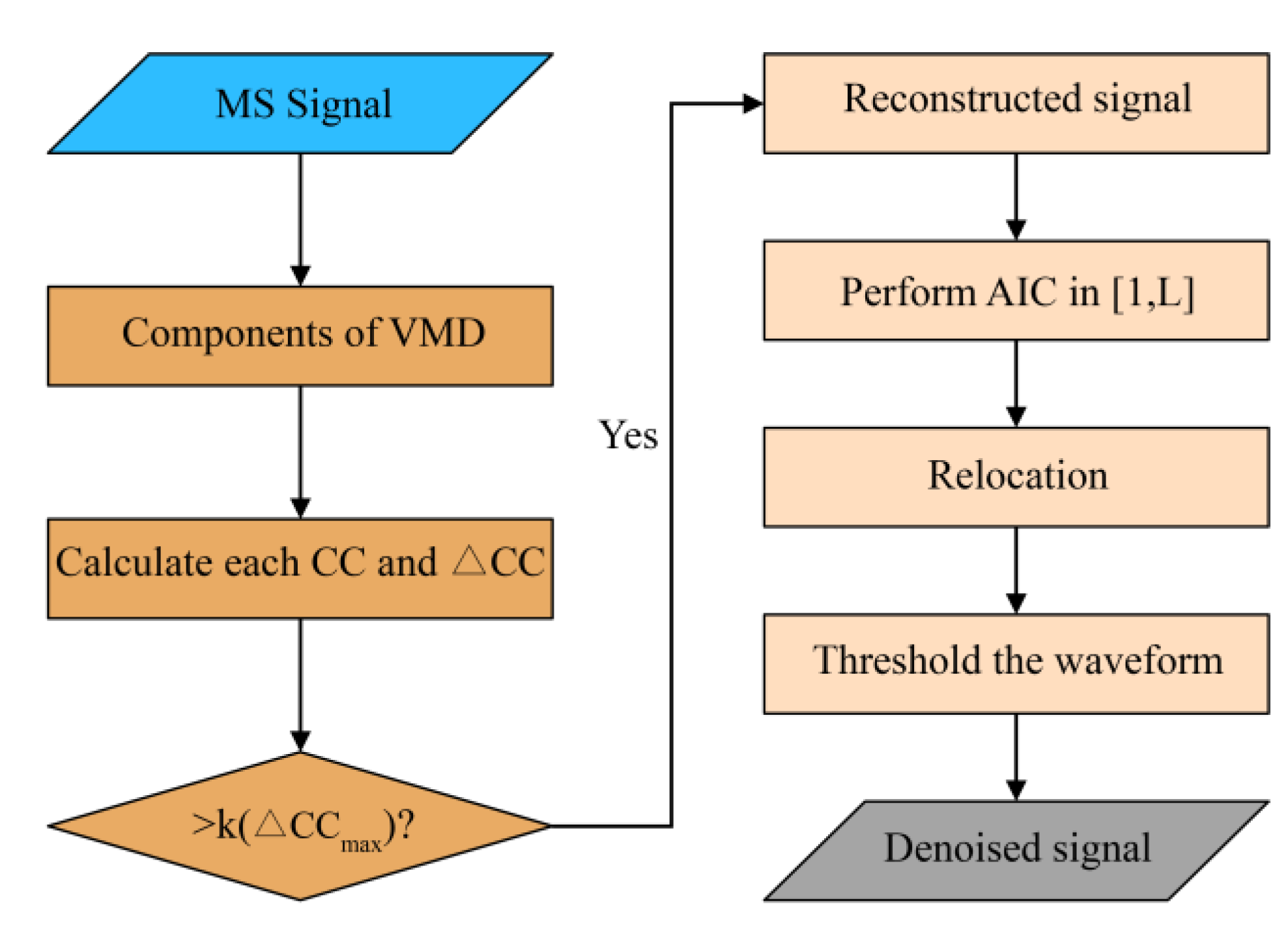

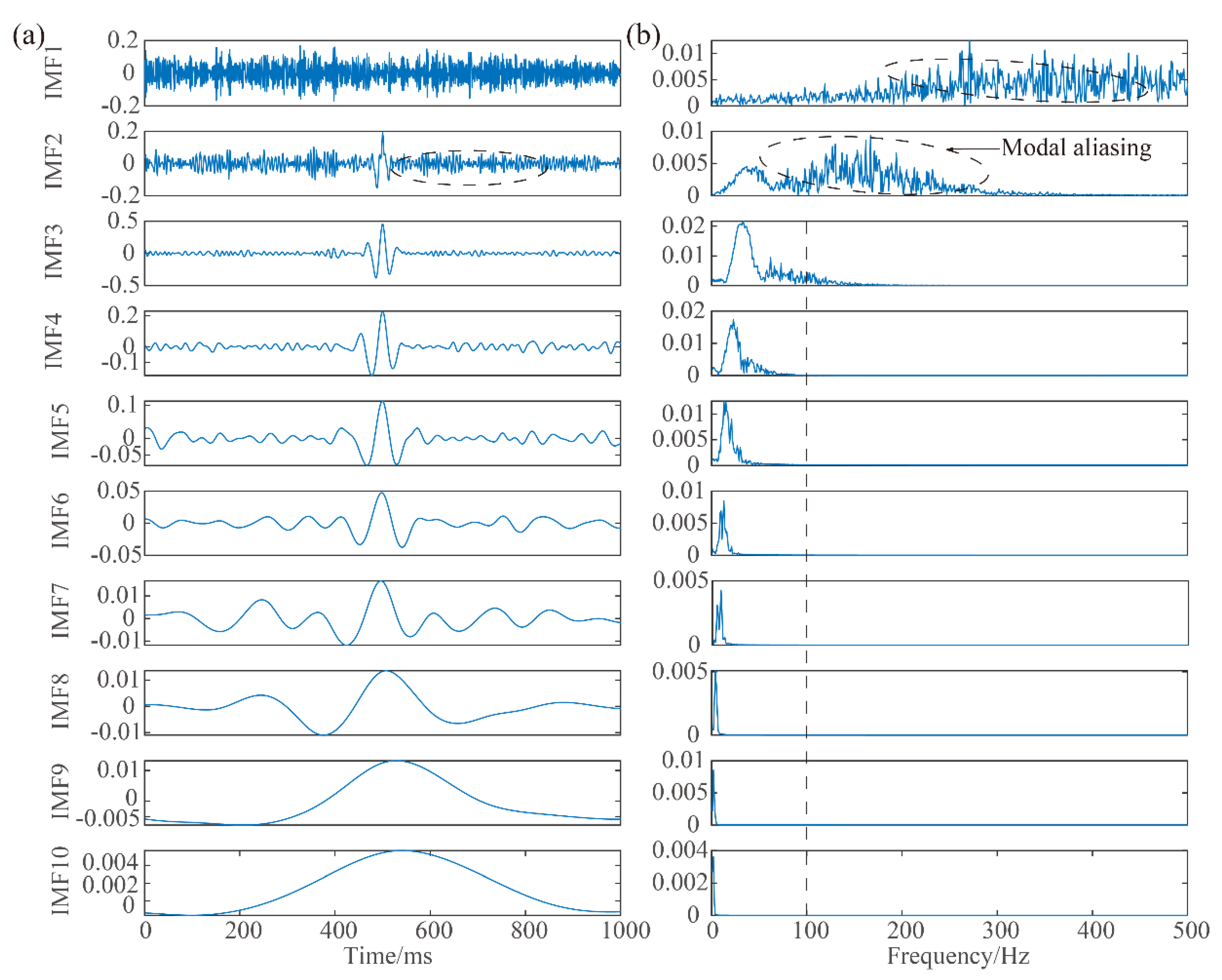
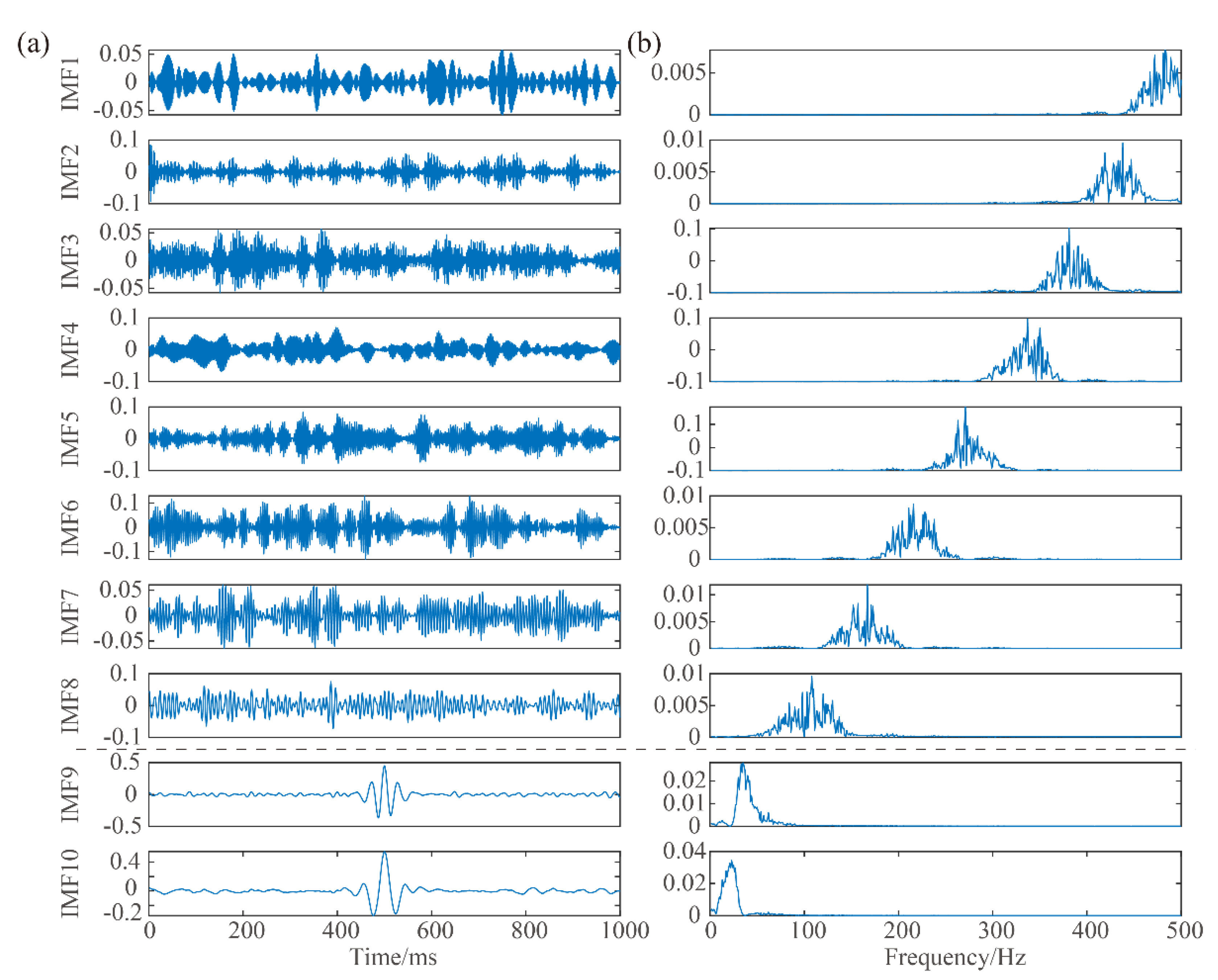



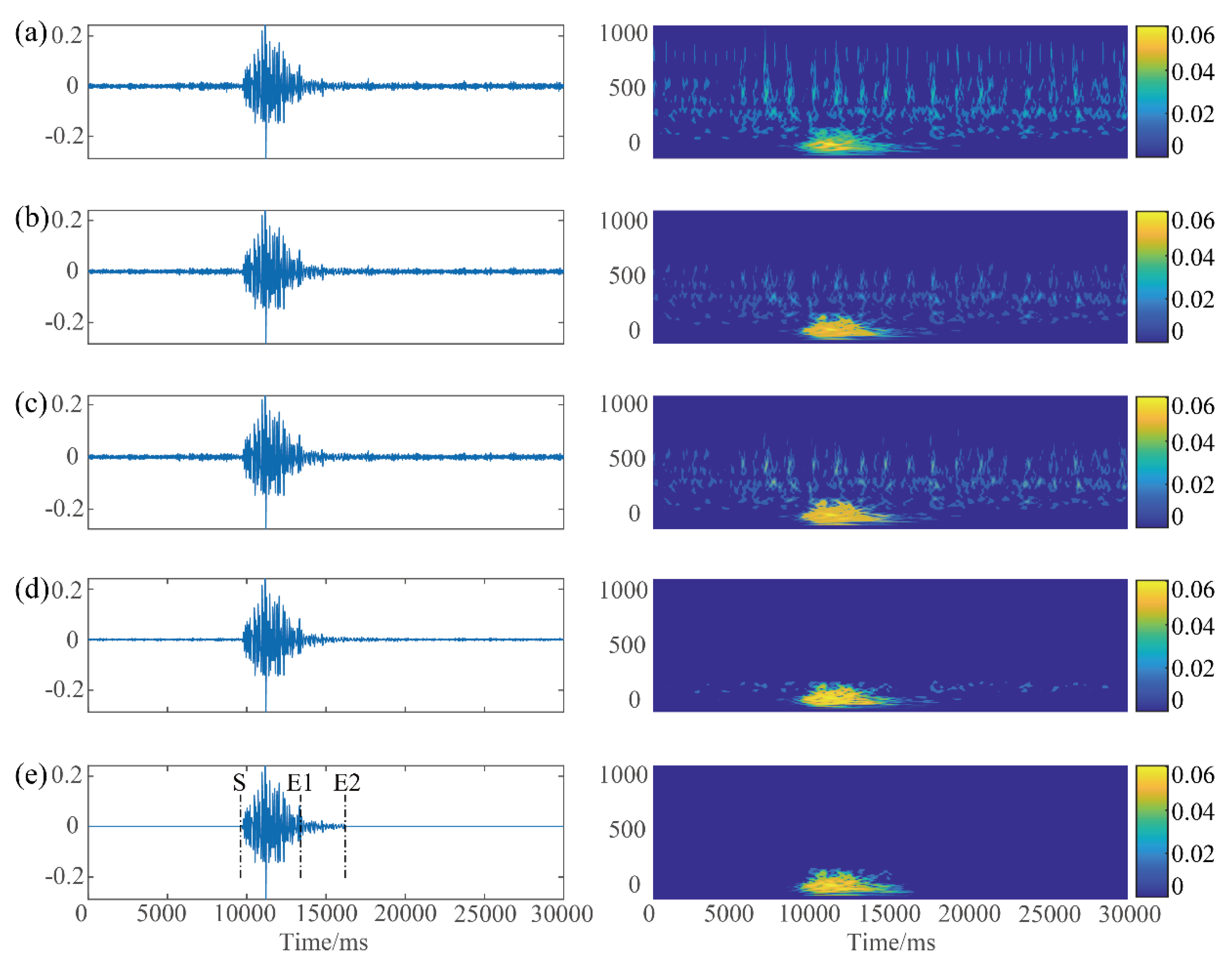
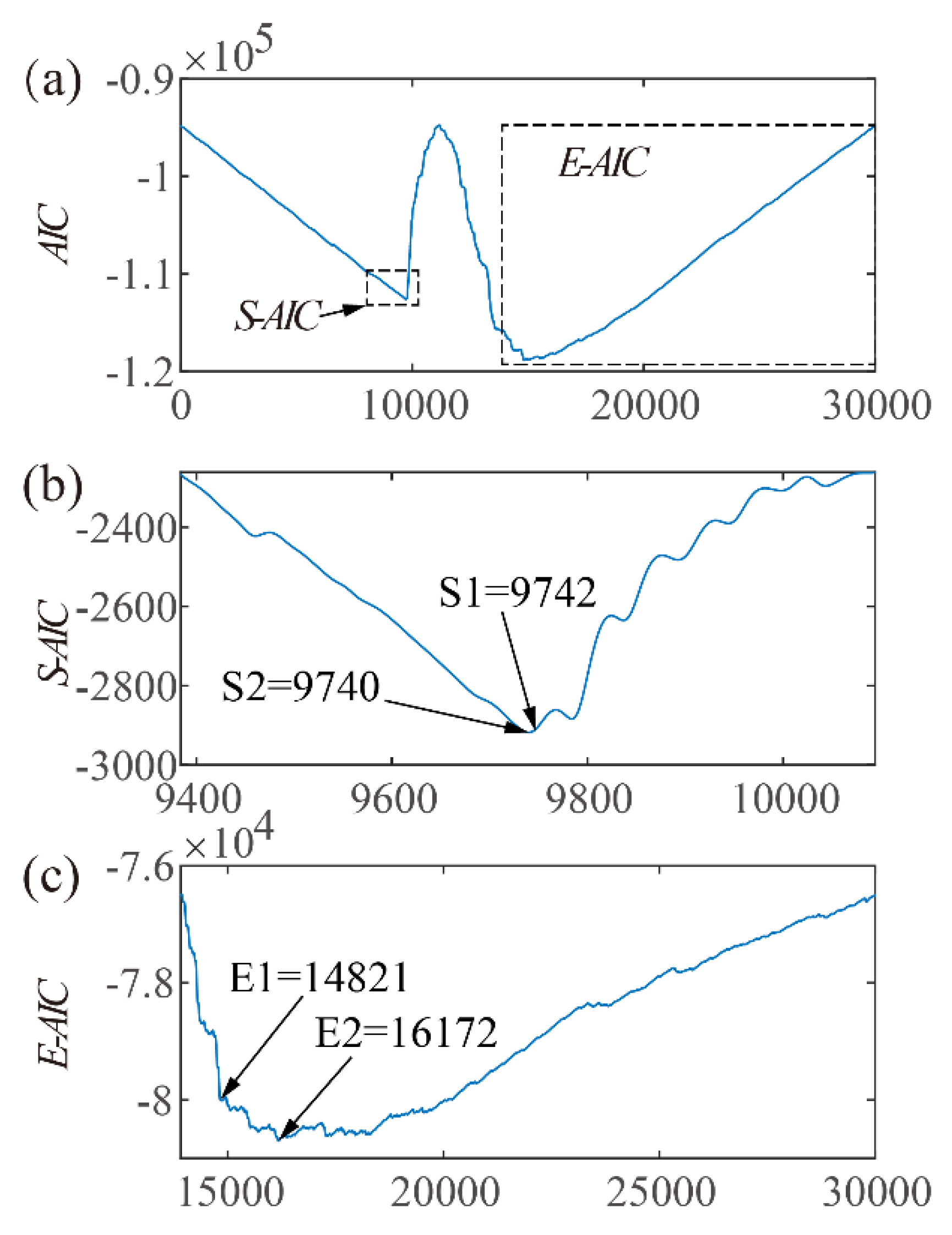
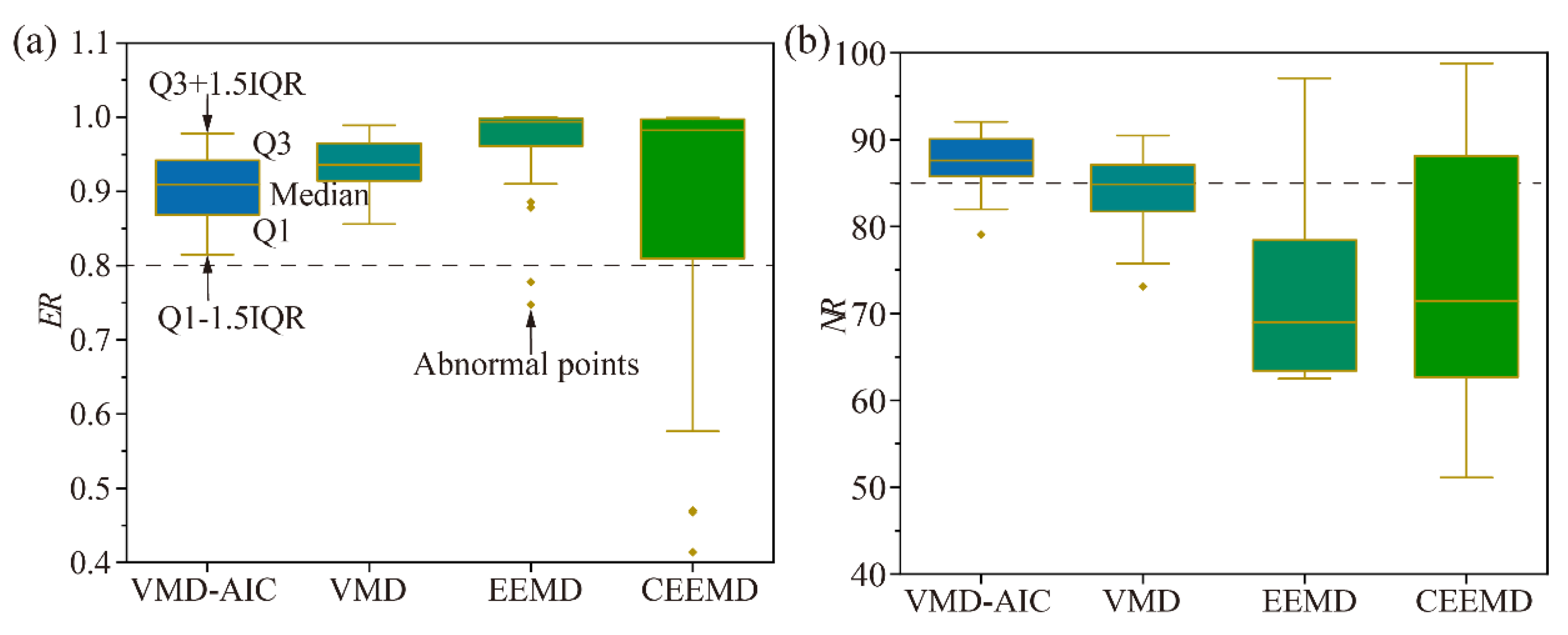
| Method | SNR/dB | |
|---|---|---|
| Before | After | |
| VMD-AIC | 2.49 | 23.47 |
| VMD | 2.49 | 11.90 |
| EEMD | 2.49 | 6.73 |
| CEEMD | 2.49 | 6.92 |
| SNR/dB | VMD-AIC | VMD | EEMD | CEEMD |
|---|---|---|---|---|
| −8 | 4.97 | 3.72 | 1.55 | −0.19 |
| −6 | 7.17 | 3.18 | 0.60 | 1.61 |
| −4 | 10.04 | 5.74 | 2.43 | 2.37 |
| −2 | 10.84 | 7.78 | 4.59 | 2.15 |
| 0 | 11.59 | 9.42 | 6.81 | 4.45 |
| 2 | 15.13 | 10.58 | 8.60 | 6.37 |
| 4 | 14.43 | 12.22 | 8.06 | 8.65 |
| 6 | 18.22 | 14.50 | 10.10 | 10.77 |
| 8 | 19.46 | 15.69 | 11.91 | 12.45 |
| 10 | 21.33 | 17.69 | 14.18 | 14.77 |
| 12 | 22.80 | 19.67 | 16.35 | 16.78 |
© 2020 by the authors. Licensee MDPI, Basel, Switzerland. This article is an open access article distributed under the terms and conditions of the Creative Commons Attribution (CC BY) license (http://creativecommons.org/licenses/by/4.0/).
Share and Cite
Zhang, J.; Dong, L.; Xu, N. Noise Suppression of Microseismic Signals via Adaptive Variational Mode Decomposition and Akaike Information Criterion. Appl. Sci. 2020, 10, 3790. https://doi.org/10.3390/app10113790
Zhang J, Dong L, Xu N. Noise Suppression of Microseismic Signals via Adaptive Variational Mode Decomposition and Akaike Information Criterion. Applied Sciences. 2020; 10(11):3790. https://doi.org/10.3390/app10113790
Chicago/Turabian StyleZhang, Jinyong, Linlu Dong, and Nuwen Xu. 2020. "Noise Suppression of Microseismic Signals via Adaptive Variational Mode Decomposition and Akaike Information Criterion" Applied Sciences 10, no. 11: 3790. https://doi.org/10.3390/app10113790
APA StyleZhang, J., Dong, L., & Xu, N. (2020). Noise Suppression of Microseismic Signals via Adaptive Variational Mode Decomposition and Akaike Information Criterion. Applied Sciences, 10(11), 3790. https://doi.org/10.3390/app10113790






